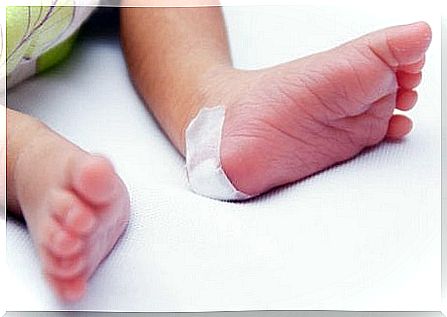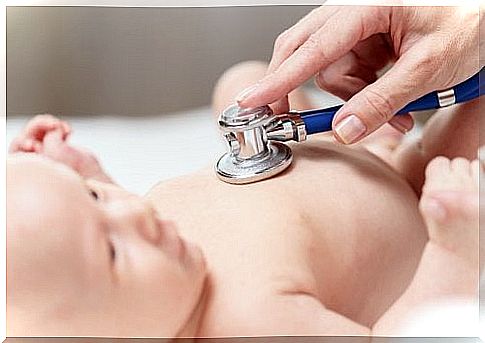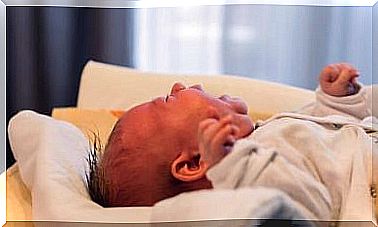The Neonatal Heel Prick On Newborn Babies

The neonatal heel prick is a very important test performed on newborn babies. This test allows the detection of certain diseases before their symptoms occur. Discover more about this routine test in the article below.
When a baby is born, the hospital performs several tests. One of these tests includes the neonatal heel prick, which occurs between 48 to 72 hours after birth.
The purpose of this test is to detect congenital metabolic defects that may affect the development of the infant. The timing of the test allows physicians to diagnose these defects before their symptoms appear.
The neonatal heel prick involves the extraction of a few drops of blood. Early clinical analysis of this blood sample allows for the detection of congenital diseases that affect the endocrine or metabolic system.
It consists of pricking the baby’s heel quickly and superficially. A trained doctor quickly places the baby’s heel and places the extracting blood on a special card. He or she then sends the blood to the laboratory for analysis.
What does the neonatal heel prick involve?
As mentioned above, the test involves a quick prick in the newborn baby’s heel to extract blood. The nurse performs the process quickly and the dot is superficial to minimize the baby’s pain.
The nurse then allows the blood to drip onto a piece of paper called a Guthrie card. Finally , the nurse sends the blood to the laboratory for analysis.
After three weeks, the results of the neonatal heel prick will be ready. In case the first blood test was not sufficient, a nurse should repeat the blood extraction again for another test.
Despite care and precautions taken by health care professionals, babies are likely to respond to the pain and cry. Therefore, we recommend that the mother lie nearby to soothe and comfort her baby immediately if possible.

What happens if the test comes back positive?
Remember that the results will not be ready in approx. 6 to 8 weeks. The results will form part of your baby’s permanent medical history and should be available for future visits.
If the results come back positive, your baby’s doctor will order additional tests to confirm the results. You must return to the hospital or clinic to repeat the extraction and testing.
If further testing confirms the positive results, parents should contact a center that specializes in metabolic diseases. The doctors who will help and guide the family in the best possible way.
The treatment will depend on the specific disease that the tests reveal. For example, in case of hyperthyroidism or congenital adrenal hyperplasia, the baby will need hormone replacements for life.
However, if the diagnosis is hemoglobinopathy, the baby should only have preventive treatment against certain infections.
What diseases does the neonatal heel prick diagnose?
The majority of the diseases that the neonatal heel prick detects are congenital metabolic defects. Even if these defects do not present specific symptoms, they can alter and compromise the baby’s proper development.
Of course, when dealing with newborn babies, most of the diseases detected are very rare. Therefore, it is very important to detect them early to intervene before the symptoms occur.

Remember that early diagnosis of these diseases does not mean that your baby can not enjoy a normal life. Below is a list of the diseases that a neonatal heel prick can detect:
- Hemoglobinopathies, such as sickle cell anemia.
- Cystic fibrosis.
- Congenital metabolic defects related to the metabolism of fatty acids, carbohydrates and amino acids, including galactosemia and phenylketonuria.
- Congenital adrenal hyperplasia.
- Congenital hyperthyroidism.
- Infections such as human immunodeficiency virus (HIV) and toxoplasmosis.
In conclusion, the neonatal heel prick is a significant test that allows early detection of congenital diseases. The test makes it possible to diagnose any kind of complication before the symptoms occur.
If you are a brand new mother, remember that you should be nearby to comfort your baby when the nurse performs the test. Remember that the test is very beneficial as it helps guarantee your baby’s health.









